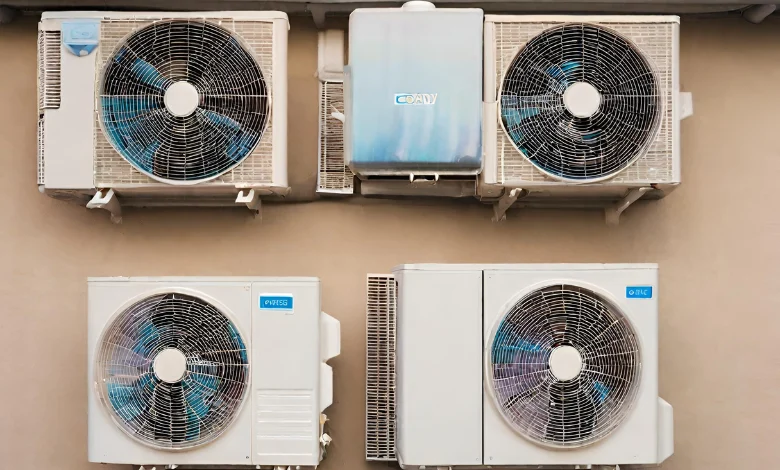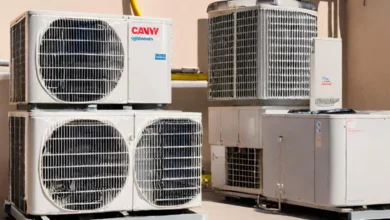How Refrigerants Contribute to the Cooling Process in AC Units

Welcome to the world of air conditioning, where the symphony of cool air and comfort is orchestrated by a silent hero – refrigerants. As we step into the cool oasis provided by our air conditioning units, it’s easy to overlook the intricate dance of thermodynamics happening behind the scenes.
Also read: Best AC in India 2024
In this exploration, we embark on a journey into the heart of air conditioning technology, unraveling the mysteries of how refrigerants contribute to the essential cooling process. From the fundamental principles of the refrigeration cycle to the latest innovations in refrigerant technology, join us in understanding the unsung heroes that make our indoor spaces refreshingly comfortable.
I. How Refrigerants Contribute to the Cooling Process in AC Units
A. Brief Overview of the Essential Role of Refrigerants in Air Conditioning
The world of air conditioning revolves around a critical component – refrigerants. These substances are the linchpin in the process of cooling, making them indispensable to the functionality of air conditioning units. Without a doubt, comprehending the role of refrigerants is vital for anyone seeking to understand the intricacies of air conditioning technology.
B. Importance of Understanding the Contribution of Refrigerants to the Cooling Process
As air conditioning becomes ubiquitous, it’s imperative to grasp the inner workings of the technology that keeps our living and working spaces comfortable. Refrigerants are at the core of this technology, and understanding their contribution is essential for technicians, engineers, and anyone interested in the efficient functioning of air conditioning systems.
C. Purpose of the Blog – To Explore the Mechanics of How Refrigerants Facilitate Cooling in AC Units
This blog endeavors to peel back the layers of complexity surrounding the mechanics of air conditioning by focusing on the unsung heroes – refrigerants. By unraveling the intricate processes these substances undergo, we aim to provide a comprehensive understanding of how refrigerants facilitate the cooling process in air conditioning units.
II. Basics of the Refrigeration Cycle
A. Explanation of the Fundamental Principles of the Refrigeration Cycle
At the heart of every air conditioning system lies the refrigeration cycle, a thermodynamic process that allows for the transfer of heat. Understanding this cycle is fundamental to grasping how refrigerants facilitate cooling. The cycle involves four main stages: compression, transportation, release, and expansion, each playing a crucial role in the overall cooling process.
B. The Four Main Components of an Air Conditioning System
An air conditioning system is a complex interplay of components, each with a specific function. The evaporator, compressor, condenser, and expansion valve work in harmony to ensure the smooth progression of the refrigeration cycle. A detailed exploration of these components is necessary to appreciate the orchestrated dance that is the air conditioning process.
C. Overview of How the Refrigeration Cycle Facilitates Heat Transfer
The refrigeration cycle is a continuous loop that facilitates the transfer of heat from one location to another. It begins with the absorption of heat from indoor air, followed by compression, transportation, release of heat to the outdoor environment, and expansion. This orchestrated dance allows for the efficient cooling of indoor spaces.
III. Absorption of Heat from Indoor Air
A. The Role of Refrigerants in Absorbing Heat from Indoor Air
As warm indoor air passes over the evaporator coil, refrigerants take center stage by absorbing heat. This process initiates a phase change in the refrigerant, transitioning it from a liquid to a gas and setting the stage for the subsequent phases of the refrigeration cycle.
B. Changes in the Physical State of Refrigerants During the Absorption Process
The absorption of heat is accompanied by a transformation in the physical state of refrigerants. The refrigerant, once in a liquid state, absorbs heat and transitions into a low-pressure gas. This phase change is pivotal in creating a cooler indoor environment.
C. Importance of This Step in Creating a Cooler Indoor Environment
The absorption of heat from indoor air serves as the cornerstone of the cooling process. Without this initial step, the subsequent phases of the refrigeration cycle would be rendered ineffective. This crucial phase lays the foundation for the creation of a comfortable indoor climate.
IV. Compression and Transportation of Refrigerants
A. Overview of the Compression Phase in the Refrigeration Cycle
Following the absorption of heat, the refrigerant, now in a low-pressure gas state, enters the compressor. The compression phase is where the magic happens – the refrigerant undergoes compression, resulting in an elevation of temperature and pressure, preparing it for the next stage of the cycle.
B. The Transportation of Refrigerants to the Outdoor Unit
The compressed, high-energy refrigerant embarks on a journey to the outdoor unit. Facilitated by the compressor, this transportation phase is crucial in maintaining a continuous flow of refrigerants through the system. The refrigerant is now primed for the subsequent stages of the refrigeration cycle.
C. How Compression Contributes to the Elevation of Refrigerant Temperature
Compression is the engine that propels the refrigeration cycle forward. As the refrigerant undergoes compression, its temperature and pressure rise significantly. This elevated temperature is essential for the release of heat in the next stage of the cycle, ensuring an efficient transfer of thermal energy.
V. Release of Heat to the Outdoor Environment
A. The Release of Heat from Refrigerants to the Outdoor Environment
In the condenser coil of the outdoor unit, the refrigerant releases the heat it absorbed from indoor air. This process involves a phase change, as the refrigerant transitions from a gas to a liquid state. The heat is expelled to the outdoor environment, completing the heat exchange process.
B. Changes in the Physical State of Refrigerants During the Release Process
The release of heat is accompanied by a transformation in the physical state of the refrigerant. As it condenses back into a liquid, the refrigerant undergoes a phase change. This phase is critical for efficiently expelling the heat absorbed from indoor air and maintaining the integrity of the refrigeration cycle.
C. Significance of Expelling Heat to Maintain a Continuous Cooling Cycle
The expulsion of heat to the outdoor environment is a pivotal step in ensuring the continuous operation of the refrigeration cycle. This process allows the refrigerant to return to the indoor unit in a state ready to absorb more heat, setting the stage for the perpetuation of the cooling process.
VI. Expansion and Return to the Indoor Unit
A. Explanation of the Expansion Phase in the Refrigeration Cycle
Having released heat to the outdoor environment, the refrigerant, now in a low-pressure, low-temperature state, enters the expansion valve. The expansion phase is where the refrigerant undergoes a controlled decrease in pressure and temperature, preparing it for the return journey to the indoor unit.
B. The Return of Refrigerants to the Indoor Unit
In this phase, the expanded, low-temperature refrigerant returns to the indoor unit, completing the refrigeration cycle. It is now poised to absorb heat from indoor air once again, initiating a new cycle of cooling. The return to the indoor unit marks the cyclical nature of the refrigeration process.
C. How Expansion Contributes to Lowering Refrigerant Pressure and Temperature
Expansion results in a controlled decrease in pressure and temperature. This prepares the refrigerant for the absorption of heat in the subsequent cycle. The expansion phase is crucial for maintaining the efficiency of the air conditioning system by ensuring that the refrigerant is in an optimal state for the continuous cooling process.
VII. Continuous Cooling Cycle
A. Recap of the Continuous Cycle of Heat Absorption, Compression, Release, and Expansion
The refrigeration cycle is a rhythmic dance of heat absorption, compression, release, and expansion. This continuous cycle ensures a consistent and efficient cooling process within air conditioning units. The seamless flow from one phase to another highlights the intricate relationship between refrigerants and the refrigeration cycle.
B. The Importance of Refrigerants in Maintaining a Consistent Cooling Process
Refrigerants play a pivotal role in maintaining the consistency of the cooling process. Their ability to absorb and release heat efficiently ensures that air conditioning units function seamlessly, providing a stable and comfortable indoor environment. Without the
contribution of refrigerants, the cooling cycle would be disrupted, leading to suboptimal performance.
C. The Efficiency and Effectiveness of the Refrigeration Cycle in Air Conditioners
The efficiency of an air conditioning system is directly correlated with the effectiveness of the refrigeration cycle. Well-designed systems, coupled with optimal refrigerant properties, can achieve higher levels of efficiency. This efficiency not only enhances cooling performance but also contributes to energy savings, making the air conditioning system both effective and environmentally friendly.
VIII. Role of Refrigerant Properties
A. Discussion on Specific Properties of Refrigerants That Enhance the Cooling Process
The effectiveness of refrigerants in the cooling process is influenced by their unique properties. Properties such as heat absorption capacity, pressure-temperature characteristics, and environmental impact play a critical role in determining the suitability of a refrigerant for air conditioning applications. Understanding these properties is essential for making informed choices in selecting the right refrigerant for optimal performance.
B. How Different Types of Refrigerants Impact the Overall Efficiency of the Air Conditioning System
The choice of refrigerant has a significant impact on the overall efficiency and environmental sustainability of an air conditioning system. Some refrigerants have been associated with ozone depletion and global warming, prompting a shift towards environmentally friendly alternatives. The discussion on different types of refrigerants delves into their pros and cons, aiding in the decision-making process for system designers and users.
C. Considerations for Choosing the Right Refrigerant for Optimal Performance
In a world increasingly focused on sustainability, choosing the right refrigerant involves a delicate balance between performance, energy efficiency, and environmental impact. This section explores the considerations that influence the selection of refrigerants, including adherence to industry standards, regulatory requirements, and the long-term impact on the environment. Making informed choices in refrigerant selection is crucial for achieving optimal performance and minimizing the ecological footprint of air conditioning systems.
IX. Technological Innovations in Refrigerants
A. Overview of Advancements in Refrigerant Technology for Improved Cooling
The landscape of refrigerants is continually evolving with advancements in technology. This section provides an in-depth overview of the latest innovations in refrigerant technology. From novel formulations to cutting-edge materials, technological advancements aim to improve cooling efficiency, reduce environmental impact, and address challenges associated with global warming potential (GWP) and ozone depletion potential (ODP).
B. High-Efficiency Refrigerants and Their Impact on the Cooling Process
The pursuit of high-efficiency refrigerants is a key driver in refrigerant technology innovation. This subsection explores the characteristics of high-efficiency refrigerants and their impact on the cooling process. High-efficiency refrigerants contribute to improved performance, energy savings, and overall sustainability in air conditioning systems.
C. Future Trends in Refrigerants and Their Potential Influence on Air Conditioning Technology
The future of refrigerants holds exciting possibilities. This section delves into emerging trends in refrigerant development, exploring the adoption of natural refrigerants, low-GWP alternatives, and advanced materials. Understanding these trends provides insights into the potential future landscape of air conditioning technology, highlighting the industry’s commitment to sustainability and continuous improvement.
X. Conclusion
A. Summary of the Vital Role Refrigerants Play in the Cooling Process of AC Units
In summary, refrigerants are the unsung heroes in the cooling process of air conditioning units. Their ability to absorb and release heat efficiently within the refrigeration cycle is indispensable for creating a comfortable indoor environment.
B. Encouragement for Readers to Appreciate the Complexity of the Refrigeration Cycle
As we unravel the complexities of the refrigeration cycle and the integral role of refrigerants, readers are encouraged to appreciate the intricate dance of thermodynamics that takes place within their air conditioning units. This newfound understanding empowers individuals to make informed decisions about their systems, fostering a deeper connection with the technology that keeps our environments cool and comfortable.
C. The Continuous Evolution of Refrigerants in Enhancing the Efficiency of Air Conditioning Systems
The world of air conditioning is dynamic, and so is the evolution of refrigerants. As technology advances, refrigerants are expected to become even more efficient, sustainable, and environmentally friendly. This continuous evolution signifies a commitment to improving the efficiency of air conditioning systems while minimizing their impact on the environment. In embracing these advancements, we pave the way for a cool and sustainable future.






